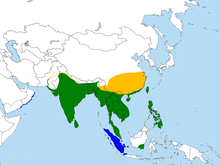Pheasant-tailed jacana
| Pheasant-tailed jacana | |
|---|---|
 |
|
| In non-breeding plumage at Bharatpur, Rajasthan, India | |
| Scientific classification | |
| Kingdom: | Animalia |
| Phylum: | Chordata |
| Class: | Aves |
| Order: | Charadriiformes |
| Family: | Jacanidae |
| Genus: |
Hydrophasianus Wagler, 1832 |
| Species: | H. chirurgus |
| Binomial name | |
|
Hydrophasianus chirurgus (Scopoli, 1786) |
|
 |
|
The pheasant-tailed jacana (Hydrophasianus chirurgus) is a jacana in the monotypic genus Hydrophasianus. Jacanas are a group of waders in the family Jacanidae that are identifiable by their wide feet and claws which enable them to walk on floating vegetation in shallow lakes, their preferred habitat. The pheasant-tailed jacana is capable of swimming, although it usually walks on the vegetation. The females are more colourful than the males and are polyandrous.
For the origin and pronunciation of the name, see Jacana.
The pheasant-tailed jacana breeds in India, southeast Asia, and Indonesia. It is sedentary in much of its range, but northern breeders from south China and the Himalayas migrate into peninsular India and southeast Asia. It is also resident in Taiwan, where it is considered endangered. It has been recorded as a vagrant in Australia.
This is the only jacana to have a different breeding plumage. The pheasant-tailed jacana is conspicuous and unmistakable. It is around 39–58 cm (15–23 in) in length, about 25 cm (9.8 in) of which is comprised by the pheasant-like tail. Body mass is reportedly 113–135 g (4.0–4.8 oz) in males and 205–260 g (7.2–9.2 oz) the larger females. The outermost primaries have a spatulate extension of 2 cm and the seventh primary has a broad protrusion.
Breeding adults are mainly black other than white wings, head, and fore neck. The hind neck is golden. There is a striking white eyestripe. The legs and very long toes are grey. Non-breeding adults lack the long tail. The underparts are white except for a brown breast band and neck stripe. The side of the neck is golden. Young birds have brown upperparts. The underparts are white, with a weak brown breast band.
Measurements (From Rasmussen and Anderton): length 310 mm 390–580 mm (breeding) Wing (with extension of primary) 190–244 mm (adults) 168–228 mm (juveniles) Bill 23–30 mm Tarsus 45–58 mm Tail 194–376 mm (breeding) 110–117 mm (non breeding)
...
Wikipedia

